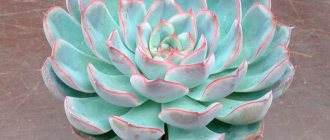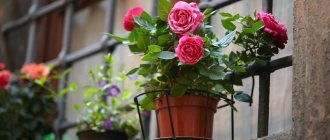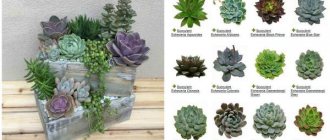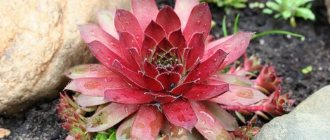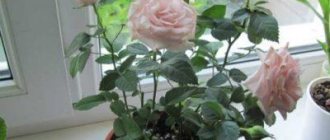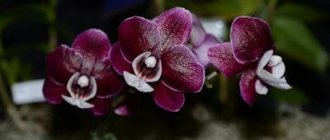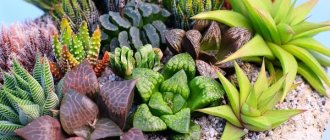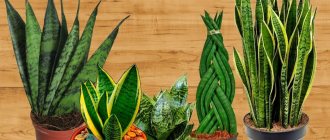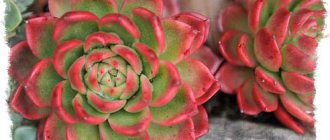Stone rose (rejuvenated) has a reputation as a very tenacious and unpretentious plant. Even its Latin name, Sempervivum, translates as “always alive.” This reputation is mainly based on the fact that the stone rose, regardless of the conditions and time of year, always remains green, easily tolerates frost, and produces numerous offspring. And if we add to these features all the properties of succulents, which is what Juvenile is, then we can assume that this reputation is completely justified.
But at the same time, you shouldn’t relax too much. The stone rose is still a flower, a living organism, and requires care, both at home and in the open ground.
A little about the plant
Stone rose has been grown as a cultivated plant for a very, very long time. The range of its application is also very wide. It was used as a roofing material, in the belief that the young plant protected against lightning strikes. How effective this protection was is unknown, but this “tile” protected perfectly from rain and other precipitation. One of the names for the young is Hare Cabbage. And this “cabbage” was eaten. Moreover, it was believed that it has unique properties that restore youth (hence the name “Molodilo”). The plant may not return youth, but the medicinal properties of the stone rose are undeniable. Juvenile ointment was used in ancient times to heal wounds, and in folk and official medicine drugs are prepared from it for the treatment of heart failure and epilepsy. And, of course, the young were and are being grown for decorative purposes. It can be planted as a ground cover plant, which will create a dense, bright carpet on the site. You can plant it as a border plant, decorate a flower bed or rock garden, or you can create an original sculpture or sculptural group. The young are also grown at home, as a houseplant.
According to the botanical classification, the stone rose belongs to the Crassulaceae family and has about 50 species. But it is quite difficult to distinguish them without deep knowledge of the subject. Even plants of the same species can differ strikingly in both shape and color. The most suitable species for growing in open ground in the middle zone is Molodil Russian.
Introduction to the stone flower
In the 19th century, a book was published called "Flora of Mexico" with illustrations by the artist Anastasio Eccheverria. Of the variety of flowers, a flower resembling a stone rose turned out to be very noticeable and unusual. This is how the plant received its botanical name - echeveria (eccheveria).
Features of Echeveria - stone rose.
Echeveria is also called stone flower or stone rose, due to its neat round rosette of leaves that have different shapes and varied colors. The plant belongs to the genus of succulents and the Crassulaceae family. Its leaves are in the form of a low rosette, the diameter of which is 5-30 cm. In the wild, there are approximately 200 species of echeveria, differing only in the shape and covering of the leaves.
The rosette may consist of flat or convex leaves, have a waxy coating or fluff, with the help of which the plant is protected from sunlight and winter frosts. You can often find a stone rose with purple leaves.
Since the plant first appeared in Mexico, which has many bright and sunny days a year, wild echeveria species have short stems. If you grow a plant indoors, it, deprived of sufficient lighting, stretches out and becomes less decorative.
A related plant, Juvenile, which is common in Europe, the Caucasus and Asia, is often mistaken for echeveria. It is also called stone rose and the plants are very similar in appearance. Juvenile is more frost-resistant, so it is not even grown indoors. Echeveria can die if the air temperature is below 6 degrees above zero. In addition, juveniles do not have stems.
Application in landscape design
A path of various types of young plants in a flowerbed
The simplest use of juveniles is to create cover areas, as well as to decorate the borders of paths or borders. This is a traditional use of the plant, used in landscape design since the times of the Roman Empire.
Juvenile has a wide palette of colors, so you can even create carpets from plants or lawns in the form of paintings with complex elements. Naturally, maintaining such a picture unchanged will require serious time investment, but the process is worth it.
A carpet with a complex pattern of various rock rose hybrids
In nature, most species of juveniles grow in mountainous areas, so they will be an ideal filler for any alpine slide or rock garden. Moreover, given that the plant practically does not require soil, individual stone rose bushes can be placed in large crevices of stones in your garden.
The use of young plants in rock garden design
An interesting option for using plants for decorative purposes is creating a florarium. This is the name of a terrarium or aquarium in which, instead of animals, there are only plants.
To some extent, the florarium is the pinnacle of minimalist landscape design - it reproduces a corner of nature on the smallest scale, which can be placed, for example, on a desk.
Typical florarium with juveniles
Juveniles are best suited as a plant for a florarium, since they require high-quality soil and some special maintenance conditions. However, one of the conditions still has to be met - a sufficient amount of light. But, as a rule, there are no problems with this, since the design of the florarium involves installing it in a sunny place or having constant lighting in the form of fluorescent (or LED) lamps. You can also use phytolamps with them.
Even in the conditions of a florarium, young plants are able to actively grow. To avoid filling the entire volume of the miniature ecosystem with it, the population should be thinned out from time to time and daughter rosettes should be planted.
Varieties of rock rose
There are, as mentioned above, about 200 species of echeveria. If we consider miniature plant species with a stem less than 10 cm long, the most common varieties are:
- Echeveria graceful, which has a light green rosette of leaves and a peduncle, the flowers of which are red-yellow.
- Echeveria Derenberg produces beautiful orange flowers and leaves with red edges.
- Echeveria bristlecone is a miniature plant with leaves covered with white bristles.
Varieties and types of stone flower.
The varieties of the most common tall-stemmed rock roses are as follows:
- Echeveria is purple, has a strong stem, at the very top of which you can see a rosette collected with pubescent leaves. The flowers are red, with yellow edges.
- Echeveria hump-flowered is distinguished by a strong stem, the growth of which is up to 65 cm.
- The most frost-resistant is Echeveria blue.
In addition to the listed plant species, nature and people have created many other types of stone roses that are beautiful in shape and color.
Popular types
For ease of choice for gardeners, popular varieties of exotic shrubs are highlighted.
Agave echeveria echeveria agavoides
The flower has a bush-like shape that does not change either in winter or in summer. It stretches 25-35 cm in height and looks like a water lily. Endowed with a short stem.
Attention! The foliage is smooth, without additional hair, and is located symmetrically. The color of the plates is a delicate green tone. At the ends of each leaf there is a translucent reddish color. The length reaches 5-10 cm, the width does not exceed 2-6 cm.
Flowering occurs in the last days of autumn or the first ten days of December. The flowers are small, do not exceed 1.5 cm in diameter, of various colors: red or yellow .
Related Echeveria affinis
Echeveria affinis was first described back in 1958 by the botanist E. Walther. The stem of the bush is low-growing, belongs to the dwarf species, does not exceed 5 cm. The height of the rosette on average reaches 8-12 cm .
The width of the foliage is up to 2.5 cm, and the length is 7 cm. The shade is rich green, reaching black. The top side has no bends, it is almost flat.
Attention! With a lack of sunlight, the foliage loses its dark color, becoming greener, and gradually begins to stretch out.
It is recommended to water early in the morning or late in the evening , when the sun's rays do not touch the bush. When watering during the day, drops that fall on the leaves provoke the appearance of burns on the tender leaves.
Graceful echeveria echeveria elegans
Elegant echeveria is a stemless species - it lacks a main stem. The rosette resembles a lotus flower. The foliage is round in shape with pointed ends pointing upward.
Important! The plate is not large, light green in color, 5 cm in length and only 2 cm in width. A bluish pile is visible on the upper side. You should not touch it, try to erase it, or carry out other manipulations. The coating is erased and cannot be restored, and the plant loses all its decorative features.
The peduncle is branched, stretches upward and ends in bright orange, red and pink bells. The ends of the bud are yellow .
Echeveria derenbergii echeveria derenbergii
The rosette of a stone rose is flat, up to 6 cm in diameter, of regular shape . The shrub is a creeping species.
The foliage has a spatulate appearance, measuring 4 by 2 cm, greenish in color, with a gray tint. A pink border appears at the edges of the plate. The greens are placed crowded, pressing tightly against each other .
Flowering begins in mid-spring. The arrows appear from the axils of the leaves located in the upper part. The height of the peduncles is 5-6 cm, on which 3-4 buds of a bright yellow rich shade .
Echeveria gibbiflora
The succulent has a tree-like stem . Large rosettes with 15-20 leaf blades are formed at the ends of the branches. The color of the rosettes is greenish-gray.
Important! The foliage is large - 15 cm wide and 25 cm long. The shape resembles an irregular oval of a curved structure, with waves along the edges. On the top surface of the leaf there are new growths of irregular shape. Thanks to the growths of echeveria, it got its name.
The bush begins to throw out buds in late August. Flowering is long - open flowers last until mid-winter. The buds appear on a long stem and look like a ball . The color of the blossoming bud is scarlet. The flower resembles a small bell, which is colored red on top and has a yellow tint inside.
One of the common varieties of humpback-flowered echeveria is Magic Red .
Metal-flowered echeveria
The peculiarity of the variety is a metallic tint . Succulents from the genus Tolstyankov, successfully growing at home, bloom. But this species almost never throws out arrows with buds .
Echeveria Lauii
The flower received its name thanks to a botanist who discovered it among other species of the genus and described its main characteristics.
The trunk of the plant is large, reaching 2-3 cm. A distinctive feature of the species are fleshy leaf plates covered with a specific waxy sheath . There is also a coating on flowers.
The upper shell is delicate and soft to the touch. It is not recommended to wash it - it is a protective layer for the plant. It is because of this coating that the plant must be handled very carefully .
brilliant echeveria
The shape of the shrub is round, but the leaf plates are strictly geometric in shape . The bush does not branch, the plates extend to a maximum of 10 cm in length, and reach only 4 cm in width. The edges of the elastic leaves in some varieties are wavy, and there are minor indentations. Color: gray with a greenish tint.
Important! Flowering occurs in the last weeks of winter, until mid-spring. A large number of flower stalks are formed on the arrows, looking like bells. The color of the buds is bright red with a yellow border around the edge.
Most often, gardeners prefer the Flying Cloud variety from this line. Its appearance resembles a head of cabbage, with a pink border appearing at the ends of the leaves.
Bristly Echeveria echeveria Setosa
The stem of the shrub is shortened or almost completely absent . Under natural conditions, echeveria grows up to 15 cm in height. The rosettes are spherical in shape, with lint present on the leaves. They are almost completely covered with thin whitish bristles.
Villi grow everywhere, even on the peduncle. The latter stretches 30 cm. Flowering begins from May to July . The buds are scarlet in color, turning yellow.
Echeveria Shaviana
Outwardly, it resembles a head of cauliflower, located on a thick stem. The foliage color is purple with a gray tint .
Along the edge of the leaf are waves painted pink. But the edging is present if the plant is in direct sunlight. If the bush is located in the shade, the color becomes faded.
The rosette size is 20 cm. Flowering occurs from July to August . The buds are deep pink.
Echeveria Pearl of Nuremberg Echeveria Perle von Nurnberg
The Von Nuremberg Pearl is distinguished by its blades with sharp peaks . They have a brown-gray tint, with a pink tint. The rosettes are large, up to 15 cm in diameter, located on a strong, straight stem. The plant blooms in late spring in a muted red tone .
Echeveria Purpuzorum or Crimson Echeveria Purpusorum
The plant does not differ in significant volumes in height and width. Its maximum dimensions are 10 by 8 cm . The main advantage of this variety is the structure of the leaf plate - it is triangular in shape with a rigid structure and a peaked tip.
The greens are olive or marshy in color with a lot of small splashes of brown. By the end of spring, the bush produces an arrow, 20 cm in height , on which red buds with an orange tint are formed.
Echeveria Miranda Miranda
The stem of a succulent has several rosettes . Thanks to this, the plant stretches up to 70 cm in living nature. The appearance of the shrub resembles a lotus flower.
Attention! This variety was developed thanks to the painstaking work of breeders. Thanks to this, there are different varieties of Echeveria Miranda, the foliage of which can be of any shade: yellow, lilac, pink, silver.
The plant is perennial, the foliage is round in shape, but with pointed ends. The plates are folded so that they form a rosette. A bush of large volumes: individual leaves are 22-25 cm, and 15 cm wide .
Echeveria Black Prince Black Prince
Echeveria Black Prince is a hybrid species. The color of its leaves is almost black. The succulent does not grow fast, it is low. Its plates are not large - only 7.5 cm in length, flattened on both sides. At the base of the plant, in the center of the rosette, the dark color is replaced by a green tone.
Flowering of Black Prince begins in the last days of October and continues until the first days of January. The plant shoots out short arrows, on which the buds glow in scarlet.
Echeveria Lilacina
Belongs to a slow growing variety. Its leaves are endowed with a dense, hard and thick structure . The size of the rosette is 25 cm, the shade of the plates varies from bluish-gray to lilac. The buds are neutral in tone - soft coral or pink.
Flowers are formed on arching reddish arrows, stretching 15 cm. Flowering occurs from the end of February to the last days of May.
If the bush is exposed to the sun, a waxy coating will appear on the foliage, which gives the flower a white color .
Echeveria Pulidonis Echeveria Pulidonis
Echeveria Pulidonis has a specific color and structure. Features of the variety :
- Succulent rosette 15 cm in diameter
- Foliage - curved, elongated, narrow, up to 6-7 cm;
- Blue plates with bright pink edging;
- There is no stem;
- Flowering is observed in summer.
The flower stalks produced are tall, bell-shaped . The buds are yellow in color.
Echeveria Sisaya Glauca
Echeveria Sizaya is distinguished by a specific shade - a bluish tone with a bluish tint. The plant has dense rosettes located directly on the ground. The foliage is short, up to 10 cm wide, but large - up to 30 cm in height.
In winter, a pink edging appears along the edges of the leaf blades. Flowering begins in spring. An arrow with yellow buds stretches out .
Desmeta
Desmeta is a classic variety of succulent, with rosettes reaching 15 cm . The foliage is a silver-blue hue, with a pink stripe along the edges. As the bush matures, it produces a creeping shoot, which can, if necessary, be rooted into a neighboring flowerpot. The plant is grown from seeds and leaf cuttings.
The bush throws out a long thin stem that stretches 25 cm. The buds are brightly colored - orange .
Nodulose
Echeveria Nodulosa is one of the low-growing species of the Crassulaceae . It grows to a height of no more than 20 cm. The plates have a beautiful pattern: on top there are red stripes along the entire perimeter, and on the bottom side there are large spots of an identical tone.
Flowers begin to appear at the end of March. The buds are bright scarlet and bloom wildly .
Echeveria Amoena
Amoena has thick shoots, with miniature rosettes formed at the ends . The greenery is bluish in color and triangular in shape. Flowers appear rarely and are yellow in color with a reddish tint. The variety is considered rare . Therefore, in order to get an exclusive specimen, you need to know how the bush reproduces by leaf.
Cushion Echeveria
A small shrub, with elongated oval-shaped plates, loose in structure . On the surface of the leaf there is a dense fringe of fibers. The color of the plant is pale greenish.
In spring it shoots out an arrow with small bell- shaped buds of a reddish-yellow hue .
Echeveria Sho
The shrub has a short stem, on which large rosettes of a greenish tint , pubescent with a bluish coating. The tops of the leaves are wavy, with cuts, ending in a peak. The buds are formed in mid-June and bloom yellow-pink .
On a note! In winter, the shrub sheds almost all its greenery, exposing a large stem.
Conditions for normal development and growth of echeveria
With proper care, it is necessary to provide the following conditions for the plant:
- Lighting. At any time of the year there should be enough bright light and direct rays of the sun. It is not advisable to place pots with plants on window sills facing north.
- Glaze. In winter and autumn, you need to water the plant moderately, once a month. In spring and summer, water it more often - when the earthen ball dries out completely. It turns out once every 10 days.
- Air humidity. Spraying the outlet is not required at any time of the year.
- Temperatures. In winter and autumn, the air temperature in a cool room should not fall below +10 degrees. In summer and spring, the temperature should be 22-27 degrees above zero.
Features of the correct growth and development of a stone rose.
Features of care
Growing echeveria will not cause any special problems and will not require much time, since the plant is completely undemanding to care.
Echeveria will be an excellent choice for busy people who forget to water their flowers, and for those who often travel on business trips.
5% discount with promo code SR5!
Especially for our blog readers.
Lighting and location selection
Stone rose is very demanding on lighting. In bright light, the leaves become dense and more decorative. You can put a flower on any window except the north one. There is no need to shade echeveria, as it is not at all afraid of direct scorching sunlight.
In summer, the succulent grows well at 18-25⁰C. In winter, 6-15 degrees is enough for him. If you cannot provide a cool winter during the winter, take care of additional lighting.
Winter-blooming varieties need good light all year round.
Watering and fertilizing
Water the echeveria only after the soil has dried three centimeters deep. In winter, watering is kept to a minimum (if you can give it a cool winter). If not, then water as in summer once every one and a half to two weeks. You need to make sure that water does not spill on the sockets, which can cause rotting.
Stone rose easily tolerates drought thanks to its fleshy leaves, but can die from overwatering.
The flower does not need spraying, as it loves low air humidity.
From March to November, echeveria is fed monthly with fertilizers for succulents, halving the concentration so as not to damage the delicate roots. In winter, fertilizing is not needed.
The soil
Stone rose requires loose soil with a neutral reaction. It is best to purchase a substrate for succulents in the store and add brick chips, gravel, expanded clay or sand to it in a 4:1 ratio.
It is advisable to add charcoal to the soil mixture to prevent the development of root rot.
Echeveria transplant
Children are transplanted annually, and adults - once every 4-5 years. Transplantation is carried out in spring.
Echeveria is planted in wide, shallow flowerpots, since its root system is located close to the surface. You can take any pot. But it is better to give preference to clay or ceramic.
A thick (one-third of the flowerpot) drainage layer must be placed at the bottom. For drainage, you can use pebbles, expanded clay, and clay shards.
It is recommended to place pebbles around the root collar, which will facilitate air access to the roots and give a decorative appearance.
Reproduction
Stone rose propagates vegetatively and generatively (by seeds).
Most often they resort to vegetative propagation using daughter rosettes (this is the easiest way), leaf or apical cuttings.
Most echeverias form daughter rosettes. They are carefully cut off and planted in separate pots.
When cutting from the mother plant, cut the cutting, treat the cut with charcoal and dry it a little. After a few hours, the planting material is planted in the substrate. Under favorable conditions, roots form within a week.
Some gardeners use an interesting method of cuttings. They tear off all the leaves from rosettes that need rejuvenation by hand, put them in a plastic container and place them in a warm place. After a month, roots and then rosettes form on the leaves.
Seed propagation is a more labor-intensive process. With the onset of the first spring days, the seeds are scattered over the surface of the peat-sand mixture and the container is covered with glass or film. Ventilate periodically to prevent mold formation.
In order for the seeds to germinate, it is necessary to maintain the temperature at 22-25⁰C and regularly spray the substrate.
The first shoots will appear in 14-15 days. Grown seedlings are transplanted into permanent flowerpots.
Diseases and pests
Echeveria is very rarely attacked by pests and diseases. Occasionally, fungi settle on it, which leads to the development of powdery mildew, dry and root rot. To save the plant, damaged parts are removed and healthy parts are sprayed with fungicides.
The most common pests are phylloxera and mealybugs. For minor lesions, you can use folk remedies (infusion of citrus peels or garlic arrows). If there are large numbers of insects, insecticides will be needed.
But most often problems arise due to improper care. The tips presented in the table will help you solve them.
| Problem | Cause |
| The leaves soften and easily separate from the stem, and the rosette rots. | Excessive watering. |
| The leaves turn yellow and fall off. | Water stagnation. |
| Yellow spots appear on the foliage. | Stagnation of water or fungus. |
| The leaves become covered with brown spots. | Fungus. |
| The leaves wrinkle and the rosette shrinks. | Watering too infrequently. |
| The stem becomes elongated, the rosettes become loose, the foliage becomes faded in color, and there is no flowering. | Insufficient lighting or cold air. |
| Stems and leaves turn black. | High humidity, low air temperature. |
| Shrinking of leaves. | Crowded pot or nutrient deficiency. |
Planting and replanting stone roses
When purchasing plants, try to ensure that the bushes you buy are healthy, the rosettes are compact, so that the plants are not elongated and do not suffer from any disease. Since the bulk of the plants are grown by sellers in a peat mixture, it is recommended to replant newly purchased echeveria immediately into loose and light soil for succulents.
Echeveria has a shallow root system, so you should not use deep pots to grow it - a wide, flat container will do. The bottom of the container should have enough drainage holes and a drainage layer that includes pebbles, broken bricks or expanded clay. The layer should not be less than 2 cm thick.
For growing the plant, light soil for cacti and succulents is most suitable. It is allowed to prepare the soil with your own hands. To do this, mix the following composition:
- Sod land - 3 parts.
- Sand – 1 part.
- Small expanded clay – 1 part.
Before planting echeveria, it is necessary to disinfect the soil. This can be done by pouring boiling water over it and then cooling. Young plants are replanted every spring. The same soil is used, but replanting is done in wider pots (a couple of centimeters wider).
How to plant and replant a stone rose.
By replanting, you can also start propagating the plant. This is done by cutting off the lateral daughter rosettes and mature leaf blades.
Choosing a location and landing rules
Juvenile does not require special conditions; the main thing for it is to find a sunny place without an excess of moisture. From the rays of the sun, the roses have a rich color, but grow to a medium size. If they are placed in the shade, they turn pale, lose their decorative effect, but become larger. There are varieties that, with a slight darkening, take on a more colorful appearance.
For growing in open ground, loose and breathable soil is suitable. There must be good drainage so that water does not linger in the soil. Fertility does not matter; the flower will grow on soil poor in nutrients, but will be small in size. Before planting, the area must be prepared, which will make maintenance easier. It is cleaned of weed rhizomes. To do this, it is better to use a pitchfork. You can simply loosen the ground without digging. Sand and fine gravel are added to it.
To plant the young, they dig holes corresponding to the size of the long taproots. Then the rhizomes are placed in the holes, the flower is pressed to the surface. Some varieties have short adventitious roots. In this case, they are simply pressed against loose soil. Planted plants should be watered so that they take root faster. Then moisturize little by little.
The planting pattern depends on the variety of sempervivum: some grow gigantic, while others have small rosettes. At first, the young ones can be planted densely after 5-10 cm, and when they grow up, they can be transplanted. The second option is to make the distance larger, and pour sand between the plants and lay out pebbles.
Florarium decoration
A beautiful and original composition can be created using several miniature succulents in a florarium. It can be created independently or purchased ready-made. The composition can be composed of various types of echeveria, cacti, Kalanchoe, young plants and other plants.
Work on creating a composition is carried out in the following order:
- First, the glass container is disinfected with alcohol.
- Fine drainage is poured onto the bottom of the container in a layer a quarter of its height, on top - a layer of soil of the same thickness, lightly compact both layers.
- It is imperative to have a drainage layer at the bottom of the container, even if it is small and small plants are planted.
- Next, plants are placed on the ground, the roots of which are lightly sprinkled with soil, which is carefully compacted.
- Pre-boiled and cooled decorative pebbles and sand are laid out on the ground (colored sand will look more beautiful). You can also put special stones for the aquarium.
- If the top layer of the florarium will be soil for the aquarium, it is better to use colored soil - it will turn out very beautiful.
- All that remains is to decorate the composition by installing figurines or floral decorative elements.
Decorating a florarium using a stone rose.
The place for the florarium should be brightly lit. The composition should be watered rarely, even less often than an echeveria growing in an open pot is watered; the soil should not become waterlogged.
If the container and soil are not disinfected, the plants may be affected by fungal infections, which quickly develop in the limited space of the florarium.
How to properly care for a stone rose
Echeveria is a rather finicky plant that requires special care.
Optimal lighting and temperature values
The most important factor for normal growth and development of plants is a sufficient amount of sunlight. The stone rose must receive a lot of light in summer and winter, otherwise it will cease to be an ornamental plant.
Proper care of a stone rose.
But air temperature is not a very important parameter for echeveria. In winter, it is better that the temperature is no higher than +15 degrees, however, lower temperatures are also allowed, but not less than 6 degrees above zero.
In the summer, take the plant to the balcony so that it stands in direct sunlight - echeveria is not afraid of burns, since it is protected by a waxy coating or pubescence of the leaves.
Name confusion
Echeveria - a plant similar to young
The name “stone rose” refers to another plant of the Crassulaceae family – Echeveria. these related species are indeed similar as both are succulents and look almost identical.
But, unlike juveniles, which mainly grow in the mountains of Eurasia, echeveria is a resident of Central America. It does not tolerate frost at all, since it is adapted to life in the arid sands of the Chihuahuan Desert.
In addition, this wild plant is much larger in size than the young one. Succulent leaves can contain large amounts of water and nutrients that have refreshing properties.
It is very difficult to grow echeveria even in apartment conditions, since providing it with the necessary temperature and air humidity is quite problematic.
How to properly water and fertilize echeveria
Feeding the stone rose is carried out once a month in spring and summer. For this purpose, special fertilizers for cacti and succulents , which are applied according to the instructions. In the autumn and winter seasons, fertilizing is not done.
In summer, echeveria requires frequent watering. It is advisable to use the bottom watering method using a tray. It is not recommended to get liquid on the leaves.
In winter, when the room temperature drops and the plants do not receive enough sunlight, watering is reduced - no more than once a month.
The healing properties of rejuvenation
The medicinal properties of the plant have been undeservedly forgotten! And quarry leaves can be used in folk medicine to prepare decoctions, ointments, and infusions. The flower has the following medicinal effects:
- anesthetic,
- disinfectant,
- healing,
- calming,
- anti-inflammatory.
Interestingly, no contraindications have been identified for taking plant-based medications. Although an allergic reaction to the components of the flower is possible, overdoses should be avoided if taken orally. Pregnant and nursing mothers should not use infusions from the plant .
It is not recommended to give to children under three years of age. Important! There are no toxic components in the composition of saxifrage.
Medicines from rejuvenate are used for the following diseases:
- stomach ulcer, gastritis,
- women's pain,
- skin problems,
- heat.
- inflammation in the oral cavity ,
- cardiovascular problems,
- epilepsy,
- diseases of the eyes and ears.
To prepare ointments, you need to take the leaves of the flower, crush them and apply the pulp to the sore spot : a wound, callus, wart, blister from an insect bite.
Juvenile juice whitens the skin and removes freckles and age spots. A decoction of the leaves is used to rinse the mouth if there are wounds or taken orally to treat ulcers. The decoction is also used to remove worms and treat hemorrhoids.
Advice! Despite the abundance of beneficial properties, you should use medicines from the plant with caution, and be sure to consult your doctor before use!
Dormancy and flowering periods
Echeveria does not have a dormant period; the plant simply slows down its growth in the winter. If you want to stimulate flowering, you can give the stone rose a rest in the autumn-winter period - put the plants in a cool room and do not water them.
Does the stone rose bloom?
Echeveria blooms most often in the summer. It produces one or more peduncles, the flowers of which are bell-shaped. If you do not want to collect seeds, it is recommended to remove the flower stalk after the plant has finished flowering, otherwise the flower will become depleted.
The beauty of sempervivum flowers
The stone rose is popular due to the decorative nature of its leaves, but it also blooms beautifully. True, each rosette blooms only once in its life. During flowering, it gradually dries out and eventually dies. In its place, children grow up and rejuvenation occurs. When purchasing new species, you should purchase young specimens, since young ones that are more than 3 years old bloom.
The tenacious flowers are graceful, beautiful, varied in color and shape. They bloom for a long time - almost all summer. The testes also have a spectacular appearance. The fruit consists of 8 to 20 multi-seeded leaflets covered with glandular fibers.
Large adult sempervivums may not bloom. But you can see the flowering of young plants. The fact is that stone roses begin to bloom due to unfavorable conditions and stress - if they become cramped, have nowhere to grow, with strong shading.
By planting young plants densely, you can cause increased flowering.
Mistakes when caring for a plant
Improper care of echeveria leads to errors that need to be eliminated.
With a lack of lighting: the shoots stretch out, the decorative effect is lost. To correct this drawback, you need to place the plant on a bright windowsill and illuminate it with fluorescent lamps or phytolamps.
With a lack of moisture: the leaves begin to wither and wrinkle. It is necessary to increase watering.
As the plant ages, the lower leaves begin to turn yellow. This is a natural process for the flower - the dried lower leaves are simply removed.
With excess moisture: leaves become swollen, yellow and watery. It is urgent to inspect the roots of the plant and the soil, transplant the echeveria into another soil, which should be air-intensive, and adjust the watering.
What hurts, who harms
The main disease of saxifrage is rot, which occurs due to excess moisture - the main enemy of the flower. Major pests include birds, worms and beetle larvae . If rot is detected, remove the affected areas and reduce watering - the main cause of rot.
If the plants were damaged by birds (crows, magpies, jackdaws), simply bury the flower torn out by the bird back. To prevent flying pests from causing damage to the flower, place a scarecrow in your garden . Larvae are more difficult to deal with. Because they are not visible. House flowers have no pests.
Control of diseases and pests of stone rose
Echeveria is rarely affected by pests. However, it happens that the plant is affected by mealybugs, which damage the leaf blades and eat up the root system. The pest is easy to recognize - its colonies look like dirty cotton wool on the leaves of the plant.
They are removed using alcohol-soaked cotton swabs. You can wash off the pests with soap suds. If the case is complex and neglected, the plant and soil are sprayed with insecticides - Aktara and Fitoverm are most often used.
When a succulent is waterlogged or the soil is affected by a fungal infection , the plant withers and rots. You can get rid of this disease only at the beginning of infection. The drugs Fitosporin or Trichodermin, used strictly according to the instructions, will help with this. However, the disease is detected late, when it can no longer be saved.
Beliefs about saxifrage
According to one of the legends in Scandinavia, rejuvenation was the plant of the god Thor. It was often planted on the roofs of houses . People believed that this would protect the house from lightning, the ruler of which was Thor. This is where one of the names of the plant came from: rejuvenated roofing sempervivum tectorum .
In Egypt, it was believed that the plant came from the seed of the god Amun. The young man was also credited with masculine strength due to the similarity of its flower to the male organ. And in England they believed that if saxifrage bloomed in the house of an unmarried girl , then she would soon get married.
According to other legends, tincture from the plant improves vision and hearing; girls rubbed its juice for blush. Some believed that if you carry a socket with you, you will not be bitten by a scorpion .
How does echeveria reproduce?
The simplest and most reliable way to propagate echeveria is to separate the lateral daughter rosettes from the mother bush. This is done during plant transplantation in the spring. The rosettes are cut with a knife, which must first be sterilized, then each cut must be sprinkled with activated carbon powder, dried and planted in the ground the next day.
Rules and features of stone rose propagation.
Description
The plant is called a stone rose only in Russia and the CIS countries; in other regions and in the scientific world, the flower is called rejuvenation. Among the people you can also find the following names: “hare cabbage”, “tenacious”. Translated from Latin, the word “rejuvenated” means “eternally alive.”
The plant belongs to the Crassulaceae family and is, in fact, a succulent. Its appearance is extremely unusual: many succulent, fleshy leaves, forming beautiful patterns, dense and durable, similar to a shell or scales. Photo on the website.
The leaves are arranged evenly and symmetrically around the main stem, which is usually not visible. Sometimes the foliage forms rosettes of larger or smaller diameter. The stone rose blooms: its flowers are shaped like stars, and in due time transform into egg-shaped fruits. In nature, you can find juveniles in the Caucasus Mountains, in the southern United States.
Propagation using leaf or apical cuttings
When, for various reasons, a stone rose does not produce children, it can propagate using cuttings: apical or leaf. Actions are performed in the following sequence:
- A young leaf located close to the trunk is cut off from the mother bush, or the top of the stem is cut off, and several leaves located at the bottom of the stem are removed.
- The cuttings are dried for several hours.
- Then the lower part of the leaf or stem cutting is immersed in a moistened mixture of vermiculite and sand.
- The cutting is installed in a place that is brightly lit. The soil is periodically sprayed.
- A month later, after the roots appear, new rosettes develop.
- This process takes from 2 to 3 months. During this period of time, wrinkling and drying of the mother leaf occurs.
- The grown young rosette is transplanted into a wide pot filled with soil for cacti.
Reproduction was young with rosettes
The main way to obtain new specimens of stone roses is through children. It allows you to grow proven varieties. Most flower species reproduce independently and very quickly. You don't even need to make an effort to do this. But you can speed up this process. The young will develop faster in a sunny place.
Reproduction with the help of children is divided into two groups:
- Varieties that produce mustaches.
- Species without long shoots.
In the first group, each whisker has a small rosette at the end. To reproduce young of this type, you need to quickly root the baby. If there is free space near the mother plant, loosen the soil nearby, press the rosette tightly and sprinkle the tendril with soil. After this, carefully water it. New sempervivums take root and grow quickly. In the future, the grown rosettes can be planted. They should be replanted together with the shoots.
If the mother flowers are located too close to each other and there is no room for rooting, allow the rosette at the end of the tendril to grow and separate it from the old plant. At the same time, make sure that the main part of the process remains with the baby. This is important because they will become tap roots in the future. If they are not left, the young will grow more slowly. The seedlings are planted for growing, while the tendrils are deepened.
Interesting! An unusual species is Rosa Rugosa. Be sure to read it.
In the second, beardless type, the young reproduce directly in the axils of the leaves. It seems that the stone rose is completely covered with small rosettes. As they grow up, they fall to the ground. Growing in the lower axils, young crops take root next to the mother plant.
Such varieties are propagated by collecting children and planting them in beds, which are moistened before planting. When the water seeps in, the surface is loosened to a depth of 5 cm. It is advisable to plant the sempervivums close to each other, and when they grow up, transplant them to a permanent place. This group of stone roses does not have taproots, so when transplanting they are simply pressed to the ground. Thin roots grow very quickly.
The first time after planting, the young ones are watered frequently, but at the same time they only moisten the soil.
Germinating rock rose seeds
If echeveria is grown from seeds purchased in specialized stores, problems, as a rule, do not arise. They are germinated as follows:
- Plant the seeds in soil consisting of peat and sand. They should be deepened by 4-5 mm.
- Then you need to water the soil with water from a spray bottle and place the container under the film.
- The resulting greenhouse is placed in a warm and bright room, the temperature in which is 20-25 degrees. It is necessary to periodically spray the soil with water and ventilate the room daily for 30 minutes.
- Sprouts appear within 2 weeks.
- When 2-3 true leaves appear, the seedlings can be transplanted into separate pots.
Echeveria, which is propagated by seed, blooms in the 3rd or 4th year.
Echeveria is a spectacular indoor plant that will delight you with its beauty and decorativeness when given enough light. Decorative original rosettes of leaves have different colors, shapes and colors.
Due to its unpretentiousness, this plant is very popular among busy people and fans of succulents and flower decorators who create stylish compositions in the florarium.
